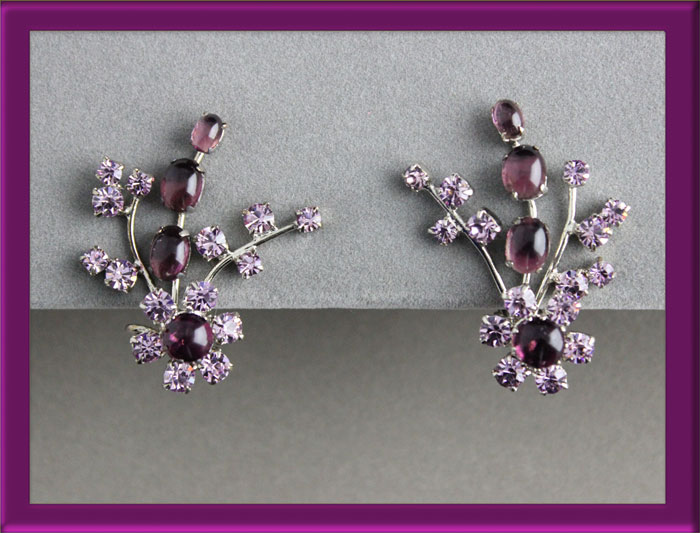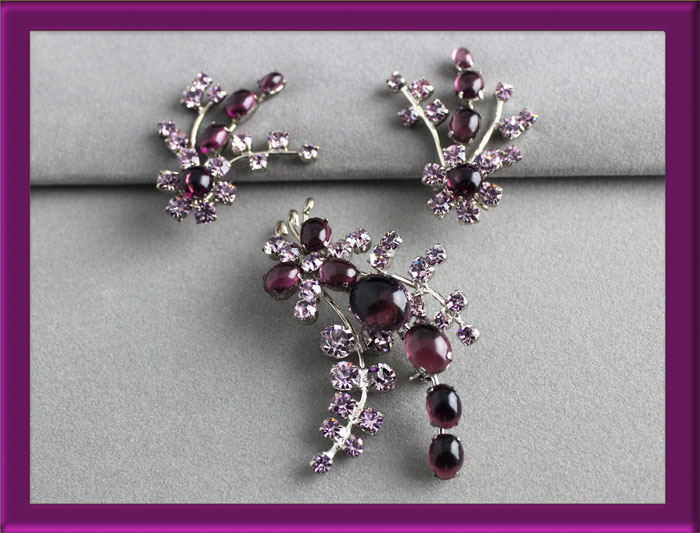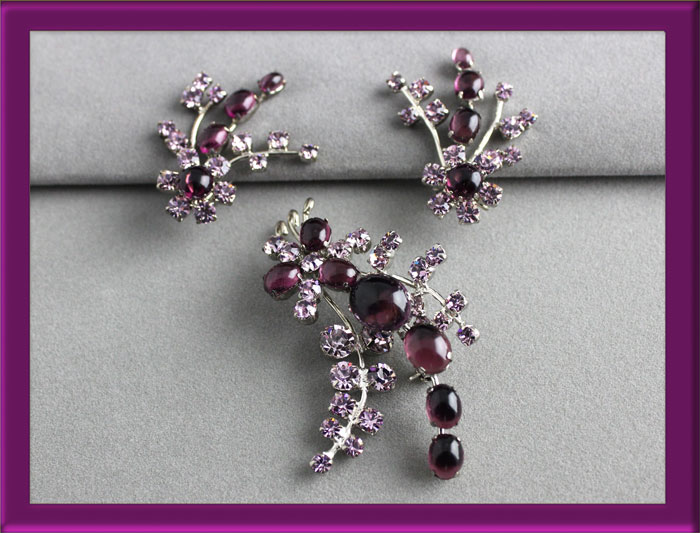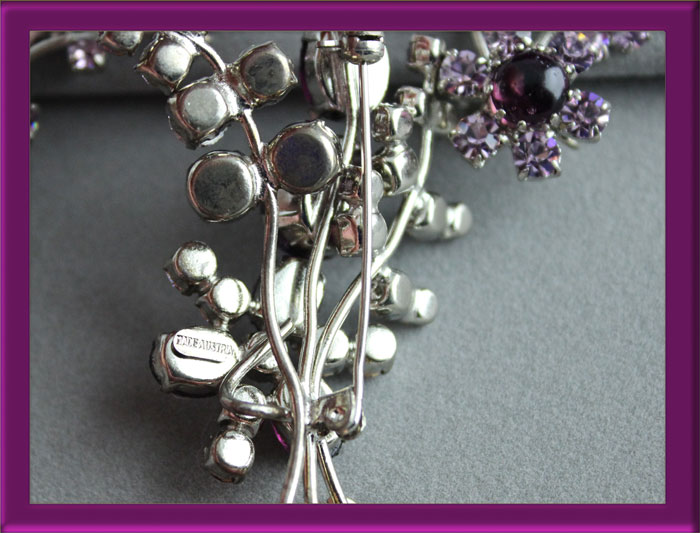Return To Previous Page
Austria | Amethyst Dragon Fly Demi Parure
Austria | Amethyst Dragon Fly Demi Parure
. . . . So Graceful!
Austria
A graceful Austrian brooch which hosts lovely oval shaped open back un-foiled cabochons in translucent pools of Amethyst. Blended with lavender rhinestones making a dainty but striking floral spray. The wire back of silver tone metal gives this brooch the illusion of swaying flower stems. All stones are prong set and the brooch is signed "Made Austria" with a roll over C closure.
This married demi parure is partnered with earrings bearing the signature of "Karu Arke". You would never know they are not an original set until seeing the reverse side yourself—they are identical. I could not help but put these two together as the same creator most certainly must have made them. The earrings are a mini version of the brooch , also of a silver tone metal with clip backs. The metal surface shows very little wear and the stones are so bright and beautiful. ID-390
Earrings — approximately 1⅝" tall by 1½ (at widest point).
Measurements:
Brooch — approximately 2⅝" tall by 1¾" (at widest point).Earrings — approximately 1⅝" tall by 1½ (at widest point).
Austria Jewelry History —
Thanks to one Daniel Swarovski, who invented the modern rhinestone, Austria has an enduring place in costume jewelry history. The 19th century glass cutter and jeweler, originally from Bohemia, developed a special foil backing that gave his cut leaded glass the appearance of diamonds. His multi-faceted crystals were such a hit, in 1892 he patented an electric glass cutter so his factory could produce these "gemstones" in significant numbers.
In 1895, Swarovski moved his company from Bohemia (now known as the Czech Republic) to Austria, and his sons joined his company in the early 1900s. All the top 20th century costume jewelers in the U.S. and around the world—including Eisenberg, Joseff of Hollywood, Trifari, and Sherman—have used Swarovski crystals, as they are considered the finest and most brilliant rhinestones available.
Coco Chanel's 1920s concept of "costume jewelry" gave Austria's rhinestone industry a tremendous boost. Naturally, local jewelers took advantage of this resource, too. Austrian firm Schoffel & Co. began producing top-notch, precisely set crystal costume jewelry in the 1930s, each piece marked with a crown, often accompanied with the words "Austria" or "Made in Austria." Schoffel jewelry, made until the 1960s, is now difficult to find and coveted by collectors.
Austria entered its darkest period in 1938, when the country was occupied by Nazi Germany. Many countries banned jewelry from Nazi-occupied regions, so Austria produced very little jewelry for export. The occupation ended in 1945, but the Austrian jewelry industry didn't recover until a few years later.
When the restrictions on manufacturing Czech and Austrian pastes, or rhinestones, was finally lifted, glass makers returned to producing "gems" in a marvelous rainbow of colors. These vivid rhinestones were often cut into large, obviously fake stones and worn in showy bib necklaces popular in the early 1950s. That same decade, Swarovski introduced its "aurora borealis" rhinestones, diamanté crystals with a special iridescent sheen. New innovations also led to machines that could cut rectangular and baguette-shaped stones, which Schoffel would set in trademark arrays.
Postwar, a newly prosperous America was crazed with consumerism, and a particular taste for whimsy. That's why, during the late '40s and '50s, Austria began manufacturing glass fruit pins almost exclusively for export to the U.S. These little brooches , made of glass that was molded or carved into the shapes of strawberries, pears, cherries, or bunches of grapes, came in vivid colors like scarlet, violet, tangerine, amber, cobalt, and emerald green.
Using Swarovski's foil-backing technique, these pieces have an even deeper shine. The stems and leaves tend be silver, gilt, or japanned metal, but those with leaves made of navette-cut or enamel crystals are even more valuable. Some fruit pins even came with matching earrings, and particularly rare pairs are marked "Germany."
Collectors Weekly: Vintage Austrian Costume Jewelry — Overview: [https://www.collectorsweekly.com/costume-jewelry/austrian]: [Date Unknown]
Having trouble with the small sizes of
yesteryear? Well, most of us do!
The ladies were smaller than the women of today.
NO Problem, be sure to check out our necklace extenders.
The ladies were smaller than the women of today.
NO Problem, be sure to check out our necklace extenders.




